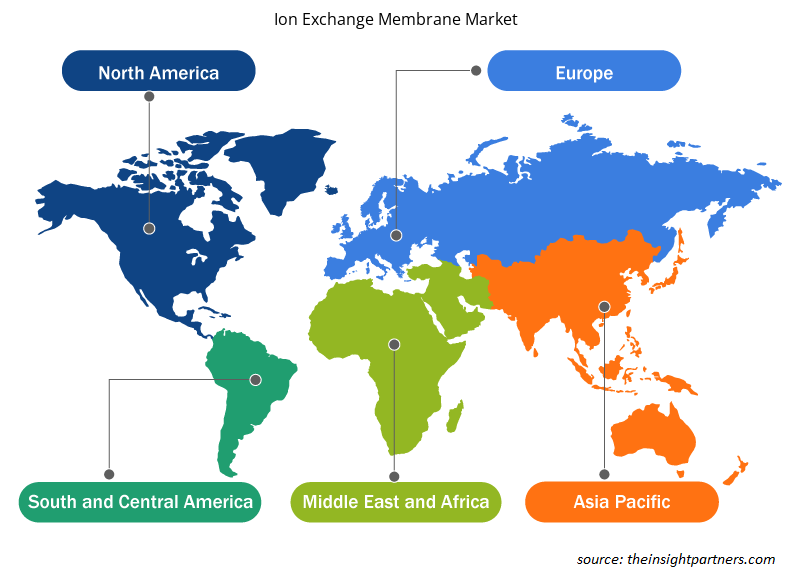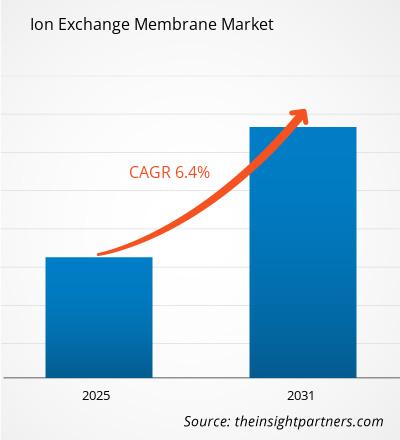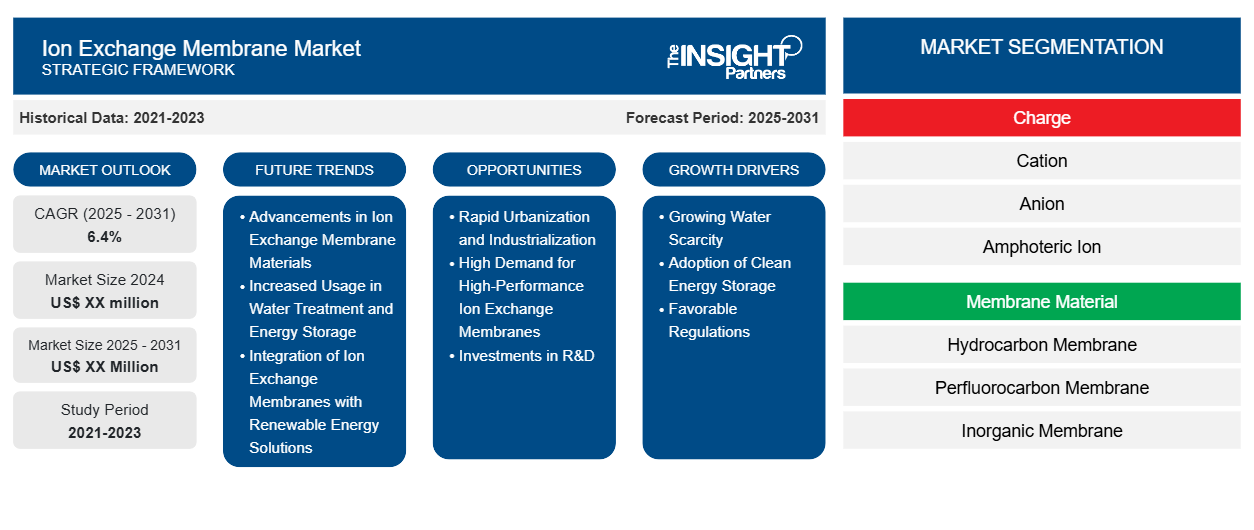预计离子交换膜市场在 2023 年至 2031 年期间的复合年增长率为 6.4%,市场规模将从 2023 年的 XX 百万美元扩大到 2031 年的 XX 百万美元。
报告按电荷(阳离子、阴离子、两性离子、双极离子和镶嵌离子)细分。报告进一步按膜材料(碳氢化合物膜、全氟碳膜、无机膜、复合膜和部分卤化膜)细分。报告进一步根据应用(电解、色谱分离、海水淡化、废水处理等)进行了分析。报告范围涵盖五个地区:北美、欧洲、亚太地区、中东和非洲、南美和中美洲以及每个地区下的关键国家。全球分析进一步细分为区域和主要国家。报告以美元为单位提供上述分析和细分的价值。
报告目的
Insight Partners 的《离子交换膜市场》报告旨在描述当前形势和未来增长、主要驱动因素、挑战和机遇。这将为各种业务利益相关者提供见解,例如:
- 技术提供商/制造商:了解不断变化的市场动态并了解潜在的增长机会,从而能够做出明智的战略决策。
- 投资者:对市场增长率、市场财务预测以及整个价值链中存在的机会进行全面的趋势分析。
- 监管机构:监管市场政策和警察活动,旨在最大限度地减少滥用行为,维护投资者的信任和信心,维护市场的完整性和稳定性。
离子交换膜市场细分
收费
- 阳离子
- 阴离子
- 两性离子
- 双极离子
- 马赛克离子
膜材料
- 碳氢化合物膜
- 全氟碳膜
- 无机膜
- 复合膜
- 部分卤化膜
应用
- 电解
- 色谱分离
- 海水淡化
- 废水处理
地理
- 北美
- 欧洲
- 亚太
- 南美洲和中美洲
- 中东和非洲
地理
- 北美
- 欧洲
- 亚太
- 南美洲和中美洲
- 中东和非洲
定制此报告以满足您的需求
您可以免费定制任何报告,包括本报告的部分内容、国家级分析、Excel 数据包,以及为初创企业和大学提供优惠和折扣
- 获取此报告的关键市场趋势。这个免费样品将包括数据分析,从市场趋势到估计和预测。
离子交换膜市场增长动力
- 日益严重的水资源短缺:随着全球水危机的加剧,对有效且可行的水净化解决方案的需求越来越大,而离子交换膜在海水淡化过程和废水处理中发挥着重要作用,它提供了一种去除污染物和盐分的可靠方法;因此,随着人口增长和工业活动导致水资源短缺的加剧,为了实现可持续的水资源管理,离子交换膜的应用必然会增加。
- 采用清洁能源存储:电动汽车和可再生能源存储加速了对高性能电池的需求。离子交换膜在液流电池和燃料电池中起着非常关键的作用,因为它们促进离子的有效转移。对清洁能源解决方案的不断增长的需求正在超越这两个行业增强的性能和可持续性能力。
- 有利的法规:废水处理和污染物去除方面的法规日益严格,这是采用离子交换膜的主要驱动力。无论是在可持续发展标准方面,行业都面临着更大的压力,需要跟上可持续发展的水平。只有在生产中应用先进的膜技术,使其更加清洁,才能促进创新和市场增长。
离子交换膜市场未来趋势
- 离子交换膜材料的进步:离子交换膜的新材料寿命更长、效率更高,能够满足各种应用日益增长的需求,是当前研究的重点。发展趋势反映了尖端聚合物复合材料和功能化材料,并致力于提高离子选择性和电导率。
- 水处理和储能应用增加:由于水处理和储能系统都趋于小型化,对离子交换膜紧凑型解决方案的需求增加。住宅和工业应用设计了更高效的系统,其小型装置可以节省空间;因此,这种转变促进了更多消费者的可及性和效率。
- 离子交换膜与可再生能源解决方案的整合:离子交换膜与替代可再生能源(包括太阳能和风能)的结合越来越多。这些膜越来越多地用于可持续水处理和能源存储应用,这些应用促进了绿色技术的发展。稳步增长的趋势不仅是为了满足环境议程,也是为了满足对更主流地采用绿色技术的潜在需求。
离子交换膜市场机会
- 快速城市化和工业化:新兴经济体的快速工业化和城市化为离子交换膜带来了巨大的增长机会。这些地区对基础设施的投资,加上对水处理、能源储存和许多其他应用的更好解决方案的追求,增加了对高效膜技术的需求,从而为市场扩张和本地化应用的发展创造了机会。
- 高性能离子交换膜需求旺盛:氢燃料电池和清洁能源解决方案越来越受到人们的关注,从而为离子交换膜领域带来了广阔的机遇。由于行业和政府热衷于投资可持续交通和发电,因此确保燃料电池中离子高效传输的高性能膜的需求有望出现爆炸式增长。
- 研发投资:研发投资是实现离子交换膜技术突破的好方法。此类创新意味着设计变化可以提高效率和选择性以及耐用性,为不同行业开辟新方向。更加注重研发应该始终意味着升级产品、占领市场份额并在不断变化的情况下保持竞争力。
离子交换膜市场区域洞察
Insight Partners 的分析师已详细解释了预测期内影响离子交换膜市场的区域趋势和因素。本节还讨论了北美、欧洲、亚太地区、中东和非洲以及南美和中美洲的离子交换膜市场细分和地理位置。

- 获取离子交换膜市场的区域特定数据
离子交换膜市场报告范围
| 报告属性 | 细节 |
|---|---|
| 2023 年的市场规模 | XX 百万美元 |
| 2031 年市场规模 | XX 百万美元 |
| 全球复合年增长率(2023 - 2031) | 6.4% |
| 史料 | 2021-2022 |
| 预测期 | 2024-2031 |
| 涵盖的领域 | 按费用
|
| 覆盖地区和国家 | 北美
|
| 市场领导者和主要公司简介 |
|
离子交换膜市场参与者密度:了解其对业务动态的影响
离子交换膜市场正在快速增长,这得益于终端用户需求的不断增长,而这些需求又源于消费者偏好的不断变化、技术进步以及对产品优势的认识不断提高等因素。随着需求的增加,企业正在扩大其产品范围,进行创新以满足消费者的需求,并利用新兴趋势,从而进一步推动市场增长。
市场参与者密度是指在特定市场或行业内运营的企业或公司的分布情况。它表明在给定市场空间中,相对于其规模或总市场价值,有多少竞争对手(市场参与者)存在。
在离子交换膜市场运营的主要公司有:
- 3M
- Axeon 水处理技术
- 陶氏
- GEA 过滤
- 通用电气公司
免责声明:上面列出的公司没有按照任何特定顺序排列。

- 了解离子交换膜市场主要参与者概况
主要卖点
- 全面覆盖:报告全面涵盖了离子交换膜市场的产品、服务、类型和最终用户的分析,提供了整体概况。
- 专家分析:报告基于对行业专家和分析师的深入了解而编写。
- 最新信息:该报告涵盖了最新信息和数据趋势,确保了其与业务的相关性。
- 定制选项:此报告可以定制以满足特定客户要求并恰当地适应业务策略。
因此,离子交换膜市场研究报告有助于引领解读和了解行业情景和增长前景。尽管可能存在一些合理的担忧,但本报告的总体优势往往大于劣势。
- 历史分析(2 年)、基准年、预测(7 年)及复合年增长率
- PEST和SWOT分析
- 市场规模、价值/数量 - 全球、区域、国家
- 行业和竞争格局
- Excel 数据集
近期报告
客户评价
购买理由
- 明智的决策
- 了解市场动态
- 竞争分析
- 客户洞察
- 市场预测
- 风险规避
- 战略规划
- 投资论证
- 识别新兴市场
- 优化营销策略
- 提升运营效率
- 顺应监管趋势





















 获取免费样品 - 离子交换膜市场
获取免费样品 - 离子交换膜市场